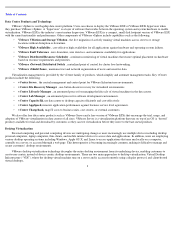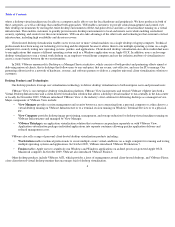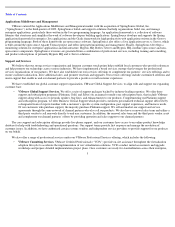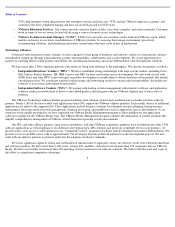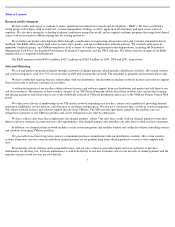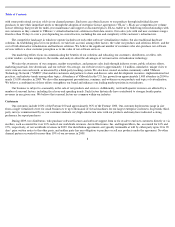VMware 2009 Annual Report Download - page 16
Download and view the complete annual report
Please find page 16 of the 2009 VMware annual report below. You can navigate through the pages in the report by either clicking on the pages listed below, or by using the keyword search tool below to find specific information within the annual report.
Table of Contents
We also face potential competition from our partners. For example, third parties currently selling our products could build and market their
own competing products and services or market competing products and services of third parties. If we are unable to compete effectively, our
growth and our ability to sell products at profitable margins could be materially and adversely affected.
Ongoing uncertainty regarding the duration and extent of the recovery from the recent economic downturn and in global economic
conditions generally may reduce information technology spending below current expectations and therefore adversely impact our revenues,
impede end user adoption of new products and product upgrades and adversely impact our competitive position.
Our business depends on the overall demand for information technology and on the economic health of our current and prospective
customers. The purchase of our products is often discretionary and may involve a significant commitment of capital and other resources. Weak
economic conditions or significant uncertainty regarding the recovery from the recent economic downturn could adversely impact our business,
financial condition and results of operations in a number of ways, including by lengthening sales cycles (for example, ELAs), lowering prices for
our products and services, reducing unit sales, decreasing or reversing quarterly growth in our revenues, reducing the rate of adoption of our
products by new customers and the willingness of current customers to purchase upgrades to our existing products.
The recent global economic disruption also resulted in general and ongoing tightening in the credit markets, lower levels of liquidity and
increases in the rates of default and bankruptcy, while the potential for extreme volatility in credit, equity and fixed income markets continues.
As a result, current or potential customers may be unable to fund software purchases, which could cause them to delay, decrease or cancel
purchases of our products and services. Even if customers are willing to purchase our products and services, if they do not meet our credit
requirements, we may not be able to record accounts receivable or deferred revenue or recognize revenues from these customers until we receive
payment, which could adversely affect the amount of revenues we are able to recognize in a particular period.
Additionally, while we plan to continue making strategic investments in our business, many of our competitors have significantly greater
financial, technical and other resources than us, and if the economic recovery is not durable, they may be better positioned to sustain investment
in competitive technologies.
Industry alliances or consolidation may result in increased competition.
Some of our competitors have made acquisitions or entered into partnerships or other strategic relationships to offer a more comprehensive
virtualization solution than they individually had offered. For example, in 2008, Red Hat acquired Qumranet, a developer of virtual infrastructure
solutions, and Citrix and Intel announced a desktop virtualization collaboration. During 2009, Oracle completed its acquisition of Virtual Iron
and Microsoft announced an additional expansion of its alliance with Citrix. Additionally, information technology companies are increasingly
seeking to deliver top-to-bottom IT solutions to end users that combine enterprise-
level hardware and software solutions to provide an alternative
to our virtualization platform. For example, in early 2010, Oracle completed its acquisition of Sun Microsystems which is both a hardware
vendor and has its own virtualization technology and Microsoft and Hewlett-Packard announced a collaboration based on Microsoft’s cloud
computing and virtualization platforms. We expect these trends to continue as companies attempt to strengthen or maintain their market
positions in the evolving virtualization infrastructure and enterprise IT solutions industry. Many of the companies driving this trend have
significantly greater financial, technical and other resources than we do and may be better positioned to acquire and offer complementary
products and technologies. The companies and alliances resulting from these possible combinations may create more compelling product
offerings and be able to offer greater pricing flexibility than we can or may engage in business practices that make it more difficult for us to
compete effectively, including on the basis of price, sales and marketing programs (such as providing greater incentives to our channel partners
to sell a competitor’s product) technology or product functionality. These pressures could result in a substantial loss of customers or a reduction
in our revenues.
13


